-
 schafferdavid
posted in output~ • read more
schafferdavid
posted in output~ • read moreHi guys, I wanted to share my latest release with you. It's an 8 tracks album that I made with fellow guitarist Jan Erick Syversen, a norvegian guitarist whom I met thru the pure data community about two years ago. The album is released under Debra Gail White's 27 club label. Here's the link:
https://theanalysis.bandcamp.com/
Thank you!
D.S
-
 schafferdavid
posted in output~ • read more
schafferdavid
posted in output~ • read moreHi guys, here's my latest video work. It's a collaborative piece made with Jan Erik Syversen. Pd is involved in both the visuals and the audio work. Hope you'll like it!
-
 schafferdavid
posted in technical issues • read more
schafferdavid
posted in technical issues • read moreThank you so much for bringing this up, I was stuck. Now I think my system will be up and running in no time. I believe the key file here is libraryname.d_fat **
It is present in zexy, not in the others. -
-
 schafferdavid
posted in abstract~ • read more
schafferdavid
posted in abstract~ • read moreHi there, working on a piece of music the other day, I digged up an old abs. of mine that I thought was woth sharing with you guys. It's a sort of LFO on steroïds that doesn't do the usual basic waveforms (except for the sine wave) but has weirder, iconoclastic waveform capabilities. I use it as an inspiration/ experimentation tool when I'm looking for radical modulation shemes for my audio. It can be hooked-up to anything that accepts a control message ranging from 0 to 1 or 0 to 127. Good for creative filtering, fx, array indexing...)
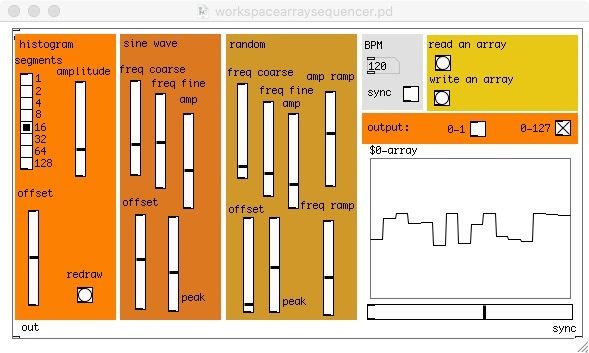
Several units can be sync'ed together using the sync output and the upper left input, so that everybody is on the same beat, there's also a possibility to save an array if you think it sounds cool...
Enjoy!
D.S
-
 schafferdavid
posted in technical issues • read more
schafferdavid
posted in technical issues • read moreThank you soooo much for this work. Just saved me hours!!
-
-
-
 schafferdavid
posted in abstract~ • read more
schafferdavid
posted in abstract~ • read moreHi there,
I recently bought a meeblip anode monophonic hardware synth. After playing with it quite a bit, I thought it missed an arpegiator, then I came across an ad for the new Tangible Instrument Arpeggio, a dedicated hardware device that does just that and I said to myself that this was something that I'd like to port to pd. I thought it would just take me an hour or two... but things got way more complicated than planned: there's quite a bit of list processing and logical/relational operations involved... Well anyway, here it is:
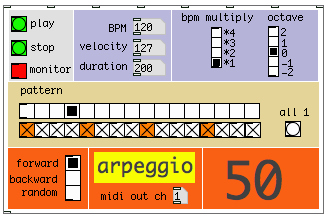
Here's the idea: you dial chords on your midi keyboard, and this abstraction turns them into arpeggios that get sent to you synth thru midi out. I browsed the web to get an idea of all the functions that are usually found in well designed arpeggiators and tried to implement them all, so here's what you get:
- variable BPM and note duration
- forward/backward/random order
- pattern design
- octave changer
- BPM multiplier
- the ability to monitor the result thru a little internal sine wave synth, so you can work "offline"
There's inlets for all the parameters and an outlet that sends the "mtof" (midi to frequency) information for further processing inside pd.
This little project was quite challenging and fun. It gave me the opportunity do work with lists in many different ways.
Please try it, modify it, improve it, share it... and make great music!
David Schaffer
-
 schafferdavid
posted in output~ • read more
schafferdavid
posted in output~ • read morehI, I've used my own pd abstraction (a sequencer, a random sample player and an mp3 glitcher, mainly) The reverb is Nuendo's default rev. The kick drum comes from a Korg elecribe drum machine, midi triggered by pd. Thank you for listening! If you want to try out my glitching abstractions, they are on the site.
David
-
 schafferdavid
posted in output~ • read more
schafferdavid
posted in output~ • read moreHi, here's a little video I made using my own glitching abstractions ( available in the "abstractions" section of the site). The result of a long pd journey inside glith. I'm excited tho share this with you!
-
-
-
 schafferdavid
posted in abstract~ • read more
schafferdavid
posted in abstract~ • read moreThank you very much for sharing this, I just gave the NES synth a try and I love it!
-
 schafferdavid
posted in abstract~ • read more
schafferdavid
posted in abstract~ • read more@austin_ep Thanks for your interest in the work. This was built on my spare time and has no connection to anything academic. I use these tools in my own artistic work. If you're intersetd in puredata and glitch art, you should definitely check Antonio Robert's blog: here. He's the one that got me into this! Oh, and you may wanna check my jpeg glitcher as well, it's on this site. Don't hesitate to drop me a line if you need guidance. Have fun!
David
-
 schafferdavid
posted in abstract~ • read more
schafferdavid
posted in abstract~ • read moreHi,
I have built a pd abstraction that glitches .MOV/.MP4 files. This is the result of a long process that involved the study and understanding of the way .MOV files work and their atom structure. Having learned a lot while developping my jpeg and mp3 glitchers, I have been willing to transpose this knowledge to the video realm. To make a long story short, my abstraction locates the mdat atom of the file, reads its length and glitches it in a user-controlable way, while leaving the rest of the filestructure untouched, allowing various degrees of glitchiness with very few unreadable files.
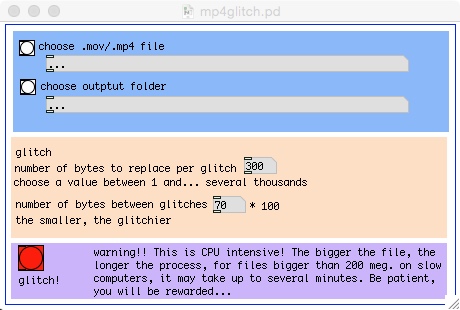
Of course, the bigger the files, he longer the processing time. I have able to glitch a 250 meg MP4 (40 minutes of video) in a bout 1 minute on a macbook pro running under OS 10.10 with the latest stable version of PD extended. On slower computers, processing may take up to 5/6 minutes. Also note that results will vary according to the codec used for compression. I have been able to get good results with H264, but they should all work. As usual with glitch, results will also vary according to the player you use. I personnaly prefer VLC . Some files may appear broken on some players and play just fine on others... Usually, if a file breaks in the process, just tweak the settings a bit to get less glitched file, it should work eventually. This is particulary thrue with small files.
Here's a bunch of stills I took from one processed video:



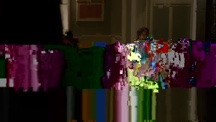
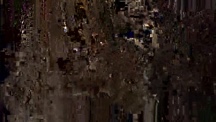
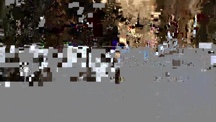

Here's the pd extend abstraction:
mp4glitcher.pd
It's a graph on parent abstraction, so the idea is to open it like an object in a blank canvas.And here's the standalone version for mac:
https://1drv.ms/u/s!AjNgShvVLV0XikkivHwWok_tpbYQYour comments are welcome!
-
 schafferdavid
posted in abstract~ • read more
schafferdavid
posted in abstract~ • read moreHi there,
I've built an abstraction that glitches mp3 files.
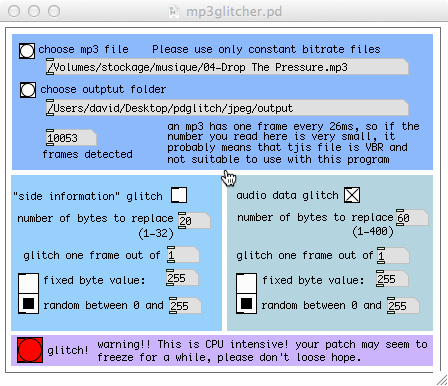
It uses some of the concepts I discovered when I was working on the jpeglitcher. After reading some documentation about the mp3 file structure, I tried to find the "sweet spots" of these files: the places where a single byte change causes the greatest possible sonic mutations.
An mp3 file is made of a succession of frames. One frame is 26,122449 ms of audio, whatever the bitrate, frequency... After a period of trials and experimentations, I realized that the best places to glitch within these files where the so called "side information" area and the audio data itself. Messing around with frame headers, as I did in the beginning, was quite hazardous: files would easily break and, if readable, they just sounded too "destroyed" and sufferd heavy time domain damage.
I think about this abstraction as a synthesis tool: a unique way for producers to process drum loops (for instance) or any other part of a song. If you use the random number glitch, each instance of glitch of the same, unalterd original file will give you a different result. Moreover: a glitched mp3 will sound differently in every software player: vlc will have its own interpretation, probably very different from Itunes or any other DAW sequencer you import this file into...For instance, drumloop5.mp3 can turn into glitch3.mp3 or glitch6.mp3 or even glitch8.mp3 opening new possibilities for experimental musicians.
The mp3glitcher is a CPU hungry abstraction when it comes to the actual glitching process. A typical 4'00" song can take up to 90 seconds to process on an old computer (but far less on more recent systems...) so don't panic if you don't get a result immediately. Also do not use this on a variable bitrate file as (for some reason beyond my comprehension) it will most likely not work.
Please feel free to use this tool and give me comments about it, so I can make it better.
mp3glitcher.pd
mp3glitcher.appTested on mac (OS 10.5 and 10.9) and PC (win. xp/7). recquires pd-extended. The zip files is the stand alone version for mac
-
 schafferdavid
posted in abstract~ • read more
schafferdavid
posted in abstract~ • read moreThen I can not garantee it works... I don't have access to that system, sorry.
-
 schafferdavid
posted in abstract~ • read more
schafferdavid
posted in abstract~ • read more@logakght Hi and thank you for using this tool. I did the best I could to reduce the number of unusable files but could'nt get entirely rid of the problem. I guess it's te price to pay when you mess up with bytes! There should not be too many of them though.
-
 schafferdavid
posted in abstract~ • read more
schafferdavid
posted in abstract~ • read more@champagnepupi Hi, and thank you for taking the time to try my abstraction. Porting it to windows was harder than I thought and It never worked on my bootcamp/XP system. I couldn't figure out why but I guess a 12 years old OS is just too old to run the latest pd stuff. Sorry about that. I tried it on a win7 system and it worked (I had to rewrite a bit of the GEM part though, to make it less CPU demanding...)
What windows version are you using?
